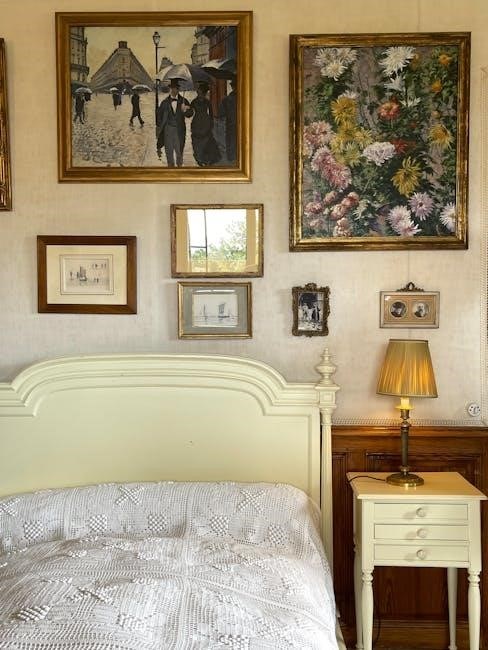
queen bed frame woodworking plans pdf
Queen Bed Frame Woodworking Plans PDF: An Overview
Queen bed frame woodworking plans PDF offer a comprehensive resource for DIY enthusiasts․ These plans provide detailed instructions, diagrams, and material lists, guiding woodworkers through the entire building process, from start to finish․

Essential Considerations Before Starting Your Project
Before diving into your queen bed frame project, carefully evaluate essential factors․ These include precise mattress dimensions, selecting appropriate wood species, and understanding the total material costs involved for the entire build․
Mattress Size and Dimensions
Accurately measuring your queen mattress is vital before starting any woodworking project․ Standard queen mattresses typically measure 60 inches wide and 80 inches long․ However, slight variations can occur․ Always confirm the exact dimensions of your specific mattress to ensure a snug and proper fit within the bed frame․ Accounting for these nuances will prevent issues during assembly and guarantee optimal comfort․ Remember, a well-fitted mattress enhances both the bed’s aesthetics and your sleep quality․ Precise measurements will save time and resources in the long run․
Wood Selection and Material Costs
Choosing the right wood is crucial for both aesthetics and structural integrity of your queen bed frame․ Popular options include pine, oak, maple, and walnut, each offering unique characteristics in terms of grain, hardness, and color․ Consider the overall style you want to achieve and the level of durability required․ Material costs can vary significantly depending on the type of wood, quantity needed, and current market prices․ Researching local lumber suppliers and comparing prices will help you stay within your budget․ Factor in additional expenses like screws, glue, and finishing supplies for an accurate cost estimate․
Tools Required for the Build
Constructing a queen bed frame necessitates a range of woodworking tools․ Essential items include a circular saw or table saw for accurate cuts, a drill with various bits for creating pilot holes and driving screws, and a sander for smoothing surfaces․ A measuring tape, square, and pencil are indispensable for precise measurements and markings․ Clamps are vital for holding pieces together during assembly․ Depending on the joinery techniques used, you might need a router, chisel, or specialized hardware installation tools․ Safety gear, such as safety glasses and ear protection, is paramount throughout the build․

Different Queen Bed Frame Styles
Queen bed frames come in diverse styles, from platform beds offering minimalist aesthetics to floating beds creating a unique visual effect․ Farmhouse styles provide a rustic charm, catering to varied bedroom designs and preferences․
Platform Bed Frame Plans
Platform bed frame plans offer a sleek, modern aesthetic, eliminating the need for a box spring and providing firm mattress support․ DIY platform bed plans often feature clean lines and simple construction, making them accessible for beginner woodworkers․ These plans can include variations with or without headboards, allowing customization to match specific bedroom decor․ Many free and paid PDF resources are available, offering step-by-step instructions and material lists for building a custom platform bed frame․
Floating Bed Frame Plans
Floating bed frame plans create a visually stunning effect by making the bed appear to hover above the floor․ This illusion is achieved by recessing the support structure inward from the edges of the bed frame․ PDF plans for floating beds often include hidden LED lighting to enhance the floating effect․ These plans require precise measurements and sturdy construction to ensure stability and safety, but the end result is a modern and eye-catching bedroom centerpiece․
Farmhouse Style Bed Frame Plans
Farmhouse style bed frame plans evoke a sense of rustic charm and warmth, often incorporating reclaimed wood or distressed finishes․ These plans typically feature robust designs with thick posts, plank headboards, and visible joinery․ Common elements include shiplap panels, decorative hardware, and milk paint finishes․ Farmhouse bed plans often emphasize simplicity and functionality, making them accessible for woodworkers of varying skill levels․ PDF plans provide detailed instructions for achieving that cozy, country-inspired aesthetic in your bedroom․
Step-by-Step Construction Guide
A step-by-step construction guide provides clear, concise instructions for building your queen bed frame․ It breaks down the process into manageable tasks, ensuring even beginner woodworkers can achieve success․
Cutting the Wood According to Plan
Accurate wood cutting is critical for a successful bed frame․ Begin by carefully studying the cut list provided in your queen bed frame woodworking plans PDF․ Measure each piece precisely, marking the cutting lines clearly on the lumber․ Use a saw appropriate for the wood type and thickness, ensuring clean, straight cuts; Double-check all measurements before cutting to minimize errors․ Remember to factor in the blade’s kerf when making your cuts to ensure each piece is the exact size specified in the plan․ Safety glasses are a must․
Assembling the Bed Frame Components
With all wood pieces precisely cut, begin assembling your queen bed frame․ Refer to your woodworking plans PDF for the correct order and method of assembly․ Start by joining the side rails to the headboard and footboard, ensuring squareness at each corner․ Use wood glue and screws or other appropriate fasteners for a strong, durable connection․ Clamps can be helpful to hold pieces securely while the glue dries․ Periodically check measurements as you build, making adjustments where necessary to maintain the bed frame’s structural integrity․
Finishing and Sanding the Wood
Once the bed frame is fully assembled, the next crucial step is sanding and finishing the wood․ Begin by sanding all surfaces, starting with a coarse grit sandpaper and gradually moving to finer grits for a smooth finish․ Remove any splinters or imperfections․ After sanding, apply your chosen finish, such as stain, varnish, or paint, according to the product’s instructions․ Multiple coats may be necessary for optimal protection and aesthetics․ Allow each coat to dry completely before applying the next․

Joinery Techniques
Joinery techniques are crucial for a sturdy bed frame․ Methods like castle joints offer robust interlocking․ Alternatively, consider knock-down hardware for easy assembly and disassembly․
Castle Joint (Shiro Joint)
The castle joint, also known as a Shiro joint, represents a robust woodworking technique․ It combines a half-lap cross joint and an intersecting bridle joint, resulting in a three-way interlocking connection; This fusion creates an exceptionally strong bond, making the castle joint one of the most reliable choices for woodworking projects requiring superior structural integrity․ Its complex design distributes stress effectively, minimizing the risk of joint failure under heavy loads or prolonged use in bed frame construction․
Knock-Down Hardware for Easy Assembly
Knock-down hardware offers a practical solution for simplifying the assembly and disassembly of queen bed frames․ These specialized fasteners allow the bed to be easily taken apart for transport or storage․ Utilizing knock-down hardware makes the frame more portable and manageable․ This is very important when moving it through tight spaces․ Options include bed bolts, corner brackets, and surface-mounted fasteners․ These systems ensure a secure and stable connection․ This eliminates the need for permanent joints and it offers convenience and flexibility․
Free vs․ Paid PDF Plans
When choosing queen bed frame woodworking plans, you’ll encounter both free and paid options․ Each offers distinct advantages, and selecting the right one depends on your experience and project requirements․
Advantages of Free Plans
Free queen bed frame plans offer an accessible entry point for novice woodworkers or those on a tight budget․ These plans provide basic instructions and diagrams, allowing builders to create a functional bed frame without any upfront cost․ Free plans are readily available online, making it easy to find a design that suits your aesthetic preferences and skill level․ It is also good for first project for beginers․
Benefits of Purchasing Detailed PDF Plans
Purchasing detailed queen bed frame PDF plans offers several advantages over free options․ These plans typically include precise measurements, step-by-step instructions with illustrations, and comprehensive material lists, minimizing errors and ensuring a professional-quality finished product․ Paid plans often provide advanced joinery techniques, customization options, and dedicated support, making the building process smoother and more rewarding․ They also ensure high quality and better understanding․
Customization and Modifications
Customization and modifications allow you to personalize your queen bed frame․ Adjust dimensions, add features like a headboard, or modify the style to match your unique taste and bedroom decor․
Adding a Headboard
Adding a headboard to your queen bed frame elevates its style and functionality․ A headboard can be designed to suit any aesthetic, from modern to rustic․ Consider incorporating features like shelving or built-in lighting for added convenience․ You can select from various materials, including wood, fabric, or metal, to complement your existing decor․ Ensure the headboard is securely attached to the frame using appropriate hardware and joinery techniques for stability and safety․ A well-designed headboard enhances the overall look and feel of your bedroom space, creating a cozy and inviting atmosphere․
Adjusting Plans for Different Mattress Sizes
Adjusting plans for different mattress sizes is crucial for a proper fit․ While queen size is standard, slight variations exist․ Always measure your mattress before starting construction․ Modify the frame’s length and width according to your specific mattress dimensions․ Account for any extra space needed for bedding or a snug fit․ Double-check all measurements to avoid errors․ Scale the plan proportionally to maintain the design’s integrity․ Consider the impact on other components, like slats or support structures․ Accurate adjustments ensure a comfortable and well-fitting bed frame․

Safety Precautions
Safety precautions are paramount when building a queen bed frame․ Always wear safety glasses and hearing protection․ Use caution with power tools, and follow all manufacturer guidelines․ Ensure proper ventilation when working with wood finishes and stains․
Working with Power Tools
When utilizing power tools for your queen bed frame project, prioritize safety․ Always wear safety glasses to protect your eyes from flying debris․ Use hearing protection, especially when operating noisy equipment like saws and routers․ Familiarize yourself with each tool’s operating manual before use․ Keep your work area well-lit and free of clutter․ Ensure that all power cords are in good condition and properly grounded․ Never operate power tools when fatigued or under the influence of drugs or alcohol․ Disconnect power tools before making any adjustments or changing blades․ Use push sticks or pads to keep your hands away from blades and bits․
Proper Wood Finishing Techniques
Achieving a professional finish on your queen bed frame requires careful attention to detail․ Start by thoroughly sanding the wood surface to create a smooth base․ Remove all sanding dust with a tack cloth or vacuum․ Apply a wood conditioner to ensure even stain absorption․ Choose a high-quality stain or paint that complements your wood selection and desired aesthetic․ Apply thin, even coats, allowing each coat to dry completely before applying the next․ Consider using a clear topcoat to protect the finish and enhance its durability․ Always work in a well-ventilated area and wear a respirator when applying finishes․
Cost-Effective Building Tips
Building a queen bed frame can be budget-friendly with smart choices․ Explore affordable lumber options and maximize material usage by optimizing your cuts․ Consider using reclaimed wood for a unique, cost-effective build․
Sourcing Affordable Lumber
When embarking on a woodworking project, especially a queen bed frame, lumber costs can significantly impact your budget․ To mitigate expenses, explore local lumberyards and mills, comparing prices for different wood types․ Consider using more common and readily available lumber, which are often cheaper than exotic varieties․ Look into purchasing lumber during sales or off-seasons to take advantage of potential discounts․ Salvaged or reclaimed wood can also be a great choice, offering both affordability and a unique aesthetic․
Maximizing Material Usage
Efficient material usage is crucial for cost-effectiveness in woodworking projects․ Before cutting any wood, carefully plan the layout of each piece, optimizing for minimal waste․ Utilize software to digitally lay out the pieces on the wood to minimize wasted space․ Consider combining smaller pieces to create larger components, reducing the need to purchase additional lumber․ Repurpose cut-offs for smaller parts of the bed frame or other projects․ Thoughtful planning and careful cutting can significantly reduce material costs and ensure a sustainable build․
Troubleshooting Common Issues
Building a queen bed frame involves potential challenges․ Addressing issues like instability, warping, or misaligned components is crucial․ This section provides solutions for these common problems․
Ensuring Squareness and Stability
Maintaining squareness during assembly is vital for a stable queen bed frame․ Use a framing square to check corners frequently․ Diagonal measurements should be equal to ensure the frame is square․ Reinforce joints with glue and screws for added rigidity․ Consider adding corner braces to enhance stability and prevent racking․ Regularly inspect the frame during construction to identify and correct any deviations from square․ A level surface is crucial for accurate assembly․
Addressing Warping and Cracking
Warping and cracking can compromise the structural integrity of your queen bed frame․ Prevent warping by using kiln-dried lumber and storing wood properly․ Apply a sealant or finish to protect against moisture absorption․ When joining wood, consider expansion and contraction․ Pilot holes can help prevent splitting when driving screws․ If cracks appear, fill them with wood filler or epoxy․ Reinforce weakened areas with additional supports․ Choose wood species known for their stability․